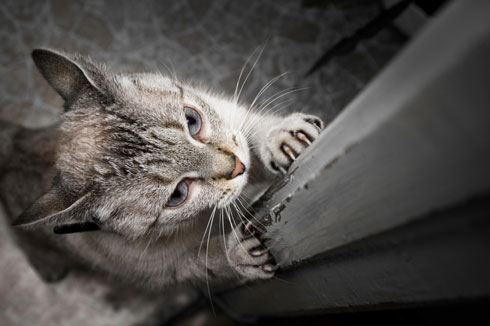- Home
- Pet Owners
- Advice for Cat Lovers
- Scratching
Scratching
Scratch it! Cats love to scratch…but why? And is it a behaviour you need to be worried about? Is it telling you something about your cat’s mood? Is it something that can be re-trained or extinguished? Well... our friends at Fear Free™ Pets have some great advice on your cat's scratching problem. Click here to download the handout (PDF). What happens when it becomes destructive? Our friends at the PPG (US) Cat Committee have produced great article and handout on Destructive scratching which is shown below; Destructive Scratching? YOUR PPG CAT COMMITEE HAS AN ANSWERImportant Reminders about the Behavior Scratching is a normal, natural behavior for cats that serves many purposes: • To communicate and modulate social interactions with other cats by: · Leaving behind a long-lasting visual mark (claw marks) and an olfactory mark by way of the interdigital glands. • To remove the layered sheaths that comprise the claws (claw maintenance). • To stretch the muscles in the backs, shoulders, legs, and paws by digging in the claws and pulling back (the only way cats can exercise the muscles in their back and shoulders). • For balance and climbing (important to a cat’s sense of safety). • To relieve pent-up emotions and stress, and to express excitement. You cannot remove your cat’s wild instincts, but you can orchestrate where they are acted out. Accept your cat for what she is – a cat – and that cats come with claws and a drive to use them. Management Techniques* • Determine your cat’s scratching preferences: · Position: vertical, horizontal, angled. • Provide various cat scratchers that are similar to the cat’s current preferences and place them in areas where the cat normally scratches. • Cats often stretch or scratch when they wake up so consider placing one near where your cat sleeps. Others scratch when in a tense situation or as a way to displace anxiety. Locate and place scratchers in all the areas where you think your cat would appreciate them most. • Place additional scratchers in pathways leading to and from the areas where the cat normally scratches and in core areas of the home—where cats instinctively do most of their scratching. • Scratching posts should be at least 6 inches taller than the cat when she is fully stretched and should have a large, stable base that prevents the post from wobbling when the cat uses it. • Make the scratching areas you want the cat to scratch more appealing. You can do this by placing catnip or silvervine near them or attaching toys to the scratching place. You can give your cat treats and play with her on or around the area too to help create a positive association with the scratcher. • After providing appropriate scratching items, as described above, clean the items you want the cat to stop scratching and make them less appealing: · Use an enzymatic cleaner to remove the scent marks left behind by the cat’s scratching.· Spray the items with Feliway® (a synthetic, odorless version of the pheromones cats use to spread their scent) twice a day to promote facial marking instead and consider plugging in a Feliway® diffuser in the area to reduce stress-related scratching. · Drape the items with a thick blanket or shower curtain, being sure to secure it at the bottom so the cat cannot crawl underneath and access the item. • Trim the cat’s claws regularly. You can condition this using treats the cat loves to help make the experience more tolerable and less stressful. *These management techniques and the behavior modification skills outlined below must be implemented simultaneously. Behavior Modification Skills • Never reprimand a cat for scratching—it is ineffective and stressful, and risks harming your relationship with your cat by creating a lack of trust and/or causing her to feel unsafe in your presence. • Don’t pull or drag the cat’s paws toward or across scratching items. This will likely be a scary experience for the cat and will cause her to avoid the scratching items. • Apply Feliscratch (made by Feliway®, Feliscratch is a synthetic version of the visual and chemical messages that come from a cat’s paws used to mark their territory) to the scratching items to encourage their use. • Lure the cat to the scratching items using catnip, silvervine and treats, or lead the cat to the items during play with interactive toys. • Reward the cat with treats, affection, verbal praise, brushing, or play when she uses the scratching items provided. Specific Tools • Scratching posts, pads, and wedges. • Enzymatic cleaner. • Thick blankets, shower curtains. • Feliscratch and Feliway®. • Catnip, silvervine, interactive toys, treats, a cat brush. • Claw trimmers. Timeline • To teach new behavior: approximately 2-4 weeks (Note: this will vary for each individual cat and may take more – or less time – than this, which is intended as a guideline only). • Maintenance: it is important to keep up your variable reinforcement schedule for use of the alternative scratching location to establish and maintain the desired behavior long-term. A Note about Declawing Declawing is not a claw trim—it is a major surgical procedure with many risks and disadvantages. Cats’ claws are part of the last bone of their toes, and in a declaw surgery, the entire first joint of each toe is amputated (see The Effects of Declawing, BARKS from the Guild, March 2017, pp.44-47: ) and PPG’s Position Statement on Declawing. Every cat is an individual, and behavior is complex. If you need help training your cat, please seek out a qualified feline behavior professional
|


